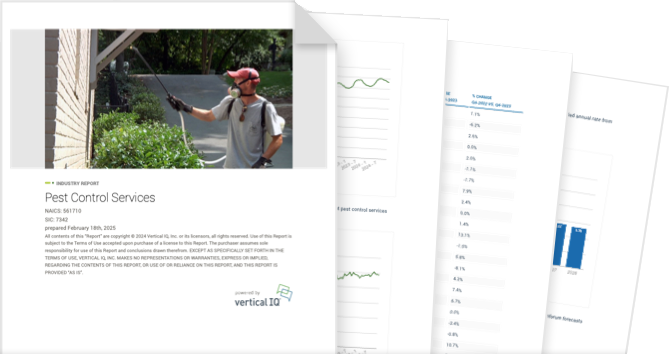Surveying and Mapping Services NAICS 541370

Unlock access to the full platform with more than 900 industry reports and local economic insights.
Get access to this Industry Profile including 18+ chapters and more than 50 pages of industry research.
Industry Summary
The 7,000 surveying and mapping service providers collect data to determine property boundaries and create maps of the Earth’s surface, including the sea floor. The processes of surveying and mapping involve measurement, documentation, and representation of the Earth’s features. Surveying is used for land planning and development, construction, infrastructure planning, real estate transactions, environmental management, navigation, and geographical analysis. Determining the boundaries, elevation, and topography of an area is critical in construction work.
Dependence on Construction and Real Estate Industries and Economic Conditions
Demand for surveying and mapping services is driven primarily by the construction and real estate industries, which are cyclical and affected by changes in economic conditions.
Drones and UAVs
The use of aerial drones and uncrewed or unmanned aerial vehicles (UAV) is growing as surveyors look for ways to cut costs and operate more efficiently.
Recent Developments
Dec 15, 2025 - Tariffs Increase Construction Project Stress
- Rising construction project stress could hinder demand for surveying services. More construction projects were paused, abandoned, or delayed in November, according to ConstructConnect’s latest Project Stress Index report. Overall, the index for stressed construction projects rose by 19.9% in November compared to October. Project abandonments jumped 41.1%, while projects on hold were up 16.5%, and bid delays increased 2.9%. In speaking to Construction Dive, ConstructConnect’s associate economist Devin Bell said, "Tariffs have played a key role in defining abandonment activity across both the public and private sectors this year. As companies deplete their pre-Liberation Day stockpiles months after initial tariffs took effect, rising construction costs are pushing some owners and developers toward project cancellations. This pressure is already visible in elevated private sector abandonments, and both sectors continue to run well above their historic averages."
- The Dodge Momentum Index (DMI) decreased 1.1% in November 2025 to 276.8 (2000=100), up from the revised October reading of 280.0. The Momentum Index is a monthly measure of the first (or initial) report for nonresidential building projects in planning, which has been shown to lead construction spending for nonresidential buildings by a full year. On a monthly basis, the commercial planning component declined by 0.1%, and institutional dropped by 3.4%. Dodge’s associate director of forecasting, Sarah Martin, said, "The influx of high-value data center work, compounded by inflationary cost pressures, continues to support elevated DMI levels. Overall, nonresidential construction is expected to strengthen in 2027, led primarily by data center and healthcare projects. Other nonresidential sectors are more likely to face softer demand and heightened macroeconomic risks."
- Construction firms that work on civil infrastructure projects are holding steady as they manage uncertainties, including waning backlog growth and stagnant margins, according to FMI’s fourth-quarter Civil Infrastructure Construction Index (CICI) survey. The CICI reading for the third quarter was 50.6 compared to 50.8 in Q3 2025 – on a 100-point scale. Any CICI reading above 50 indicates that more civil infrastructure contractors see conditions as good than poor. About half of civil infrastructure contractors reported that their backlogs in Q4 met or exceeded their targets. However, most noted that public projects are making up a growing share of overall backlogs, as private-sector projects face greater uncertainty. Contractors expect backlog growth to slow over the next few quarters as more firms vie for a narrower set of public projects. Contractor margins remained steady but flat in Q4 2025 as bid competition and rising cost pressures eroded pricing power.
- The 43-day federal shutdown, the longest in U.S. history, ended November 12, but construction industry disruptions persist, according to Engineering News-Record. Infrastructure agencies, including the Department of Transportation, the Environmental Protection Agency, and the Army Corps of Engineers, remain under a continuing resolution through January 30, 2026, which limits spending, staffing, and new program starts. Contractors are facing mounting delays in grant agreements, environmental reviews, and permit approvals, particularly for transportation, water, and civil works projects. Inflation and seasonal timing compound risks, as procurement delays may drive up material costs. Public owners must still meet Infrastructure Investment and Jobs Act deadlines despite slowed federal processing. The reopening offers a path forward, but recovery will be gradual, requiring strategic planning across the construction sector to manage uncertainty and maintain momentum.
Industry Revenue
Surveying and Mapping Services

Industry Structure
Industry size & Structure
The average surveying and mapping company operates out of a single location, employs about 8 workers, and generates about $1.7 million annually.
- The surveying and mapping industry consists of over 7,000 firms that employ over 54,800 workers and generate over $11.7 billion annually.
- The industry is fragmented with the top 50 companies accounting for about 25% of industry revenue.
- Firms that generate less than $1 million account for over 70% of the industry. Firms that generate $5 million or more account for more than 45% of the industry revenue.
- Surveying and mapping firms are primarily local businesses; most companies are small, independent operators that serve a limited geographical market. Larger firms have a regional or multi-state presence. Major engineering and construction companies, like Dewberry and Stantec, provide surveying and mapping as part of their comprehensive services.
- Independent surveying firms may consist of a single licensed land surveyor and an assistant. Mid-size firms employ teams of five to 50 workers overseen by one to two licensed surveyors and may offer related professional services. The largest firms manage 50 to 1,000 employees and work in multiple states.
Industry Forecast
Industry Forecast
Surveying and Mapping Services Industry Growth

Vertical IQ Industry Report
For anyone actively digging deeper into a specific industry.
50+ pages of timely industry insights
18+ chapters
PDF delivered to your inbox
